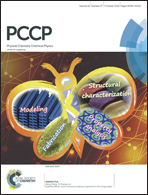Mechanistic aspects of thioflavin-T self-aggregation and DNA binding: evidence for dimer attack on DNA grooves†
Abstract
Thioflavin-T (TFT) is a fluorescent marker widely employed in biomedical research but the mechanism of its binding to polynucleotides has been poorly understood. This paper presents a study of the mechanisms of TFT self-aggregation and binding to DNA. Relaxation kinetics of TFT solutions show that the cyanine undergoes dimerization followed by dimer isomerisation. The interaction of TFT with DNA has been investigated using static methods, such as spectrophotometric and spectrofluorometric titrations under different conditions (salt content, temperature), fluorescence quenching, viscometric experiments and the T-jump relaxation method. The combined use of these techniques enabled us to show that the TFT monomer undergoes intercalation between the DNA base pairs and external binding according to a branched mechanism. Moreover, it has also been observed that, under dye excess conditions, the TFT dimer binds to the DNA grooves. The molecular structures of intercalated TFT and the groove-bound TFT dimer are obtained by performing QM/MM MD simulations.



 Please wait while we load your content...
Please wait while we load your content...